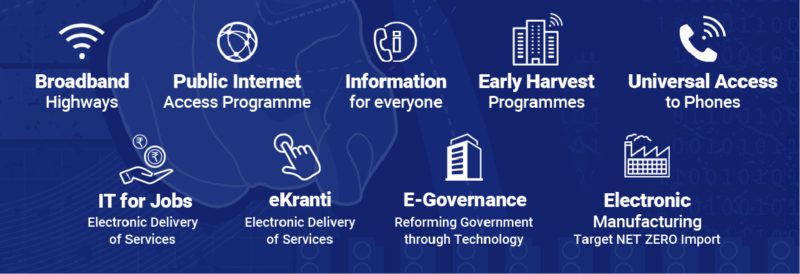Every once in a while, a new technology or innovative practice takes the world by storm, but soon the technology or practice becomes more of a fad than a way of life. It changes the pace and scope and disrupts for a while, after which another trend takes over. Digitalization stands out because it has shown that it can be a real equaliser, a fast track to growth and development, and could solve problems hitherto not touched yet for want of even a semblance of an available solution.
For a country like India, which has 70 years of freedom behind it, digitalization could be a real game-changer. Its extensive reach, seamless connectivity and mass digital literacy are aspects that can truly ring in the dawn of a digitalized India. With the Internet of Things (IoT) revolution and upward graph of economic growth, a truly digital India in the next five years is not an unreachable goal. The seed of a massive revolution that digitalization holds within it has potentially opened up unlimited opportunities for businesses—to pioneer this transformation, to achieve increased profitability in the process and to enable businesses achieve customer delight.
A few critical aspects that all businesses, startups or proven industry leaders need to lay emphasis on in order to attain their digital best and help the nation’s goal post of a digital India are discussed in this article.

With transparency we will see value
The modern consumer, who has embraced e-Commerce, needs, expects and demands transparency. We have always had an uncaring attitude about the lack of transparency prevailing in most government services. However, the government has begun to take key steps to digitize its services for the public, because it sees the value in these services. Digitalization can help in the transmission of government subsidies and benefits to the last mile, thereby reaching the remotest areas, and truly democratise. This opens up the possibilities of digitizing all public services offered to the common man. The difference it would make to governance could be overwhelming.
While information and process clarity is visible across the Web and portals, these can be extended to mobile devices as well. Businesses are changing their strategies to get their services out through mobiles and to a heavily mobile-using audience. Also, digital channels and social media are leveraged to promote the existence of such government services and enhance its usage. Digital India is one such initiative that has gained traction through it.
The freshness of innovation
Everyday niche products and services are thought of and brought to the market, thanks to innovation, without which sustainability of businesses hangs by a thread. Benefits of efficiency in production and operations has given innovation that status. A simple thing like connecting rural and agrarian communities with the Internet is making a vast difference in the quality of lives of the people there. Mobile money and digital healthcare services are a few areas that are making inroads to help marginalised communities.
Innovation results in solutions that would transform the way businesses and government bodies communicate with the customer/stakeholder contextually and ubiquitously. This almost magical quality of omnipresence and omniscience is exactly what governments and businesses can achieve through a structured digitalization strategy.
Empowering businesses and the government to transcend to the next level
While the India growth story has been providing good sources of funding for new-age businesses, they need to find their feet faster than their more established counterparts. Their longevity is subject to the vagaries of markets, the dynamic consumer psyche and the disruption caused by new technologies. An optimal digitalization approach is the only solution that will spur the zesty startups to sustain and cross-over to establishments that can make a mark in history.
As the way things evolve with services and businesses, enterprises seek the digital revolution as an opportunity to create new-age solutions and take the customer experience to the next level. This is being mobilised in order to address these evolving business requirements. Firms are introducing dedicated enterprise business applications and digital transformation practice, under which an attempt is being made to help customers gain a technological edge over competitors, by deploying essential business solutions and enhancing their business processes.
Digitalization changes everything
Digital transformation has changed the way technology companies think. Today, we know that the heads of marketing, finance and even human resource seek digital services as much as the technology heads. Digitalization has impacted the way organisations work, set their internal processes and interact with their employees, as much as how they interact with their customers.Today, digitalization is not an option or even a need, but an imperative. Adopting digital transformation practices in all aspects is what differentiates the best companies from the whole lot, irrespective of the sector these operate in. Digital transformation by itself is a paradigm shift in mindset, technology adoption, process and people alignment. It cannot happen overnight, but is ushered in through a series of steps—just like industrialisation in India took long, hard years. The only difference here is that digital transformation would take a lot less time and impact a lot more.
While talking about digitalization, organisatons or, for that matter, governments need to ensure customer satisfaction and a delightful end-customer experience. If the solution or service does not create value for the customers or end users, it may end up being just a fad.
Automation of business processes across an organisation is demanding and requires a robust and well-connected application ecosystem. Whatever enterprise resource planning offering is used, it should seamlessly connect all business functions to facilitate the exchange of information and collaborative working.
Also important for organisations is to excel in creating a seamless online experience with their user interface and user experience capabilities to capture the interest of their target audience and keep it constantly engaged. Keeping it together would be integrated digital initiatives to help maximise resources and deliver better outputs.
The goal of Digital India, with focus on connectivity as a Wi-Fi symbol in its logo suggests, is not that far. With more investments and better services, we could be at a cusp of a true revolution here, because businesses in a nurturing ecosystem, powered by digitalization, are creating the change that we hoped for this long.










